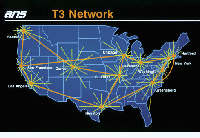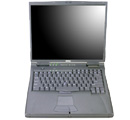Welcome to the History of Computers and the Internet web page! |
 |
Computers were pioneered in the crudest form by ancient people in the form of abacuses, then later, not long before the Industrial Revolution, mechanical computational devices.
ENIAC, one of the first computers, was used for military weapon enhancement calculations. This machine had less power than a modern hand calculator. Steve Wozniack was the first person to create a personal computer after the invention of microchips, which replaced thier unreliable, snail-paced, and bulky forefathers, the less powerful transistors. Since the creation of Apple 2, the personal computer industry has expanded and sold millions of computers which replaced punch-card machines and found thier way into homes, schools, businesses, and modern life as we know it. Computers and The Internet: Growing, Changing A physical map of the Internet, (below) shows growth taking place in the now-publically accesible 'Net. 
The map above is also a link to Hobbe's Internet timeline. |
 |
|
|  |
Early Computers 
Above is a link to www.computerhistory.org
The first fully electronic digital computer, the Z1 (above) was created by Konrad Zuse in 1938, seven years before creating a programming language. The Z3 was the first fully functional electromechanical computer that ran on an operating program. It was built in 1941, and neither the Z3 or the the Z1 survived past WW2. |
 |
Computers- Now and Then (articles above, below)

Computers continue to grow smaller and faster, causing increasing industrial automation and buyer convenience. The Internet- Now and Then (article below) The internet was started by the Department of Defense in 1962, when the 10,000 computers that existed on the face of the earth had about as much power as a digital watch apiece. It was deemed a high-risk, high-gain operation, and it connected major universities to secure their research in the case of war or a natural disaster. At that time, it was known as ARPANET. The ARPANET expanded within the goverment and miltitary for many years.
ARPANET obtained more hosts, protocols (standards for sending and recieving information) , and networks. In 1973, there where thirty networks hooked up to ARPANET, a huge expansion from the less than ten that started it all. In 1975, the Department of Energy created thier own network system to keep track of data. The ARPANET went public in 1984, then six years later, ARPANET shuts down, close to the time the World Wide Web was created to allow multimedia to travel through the net. |
|
|

